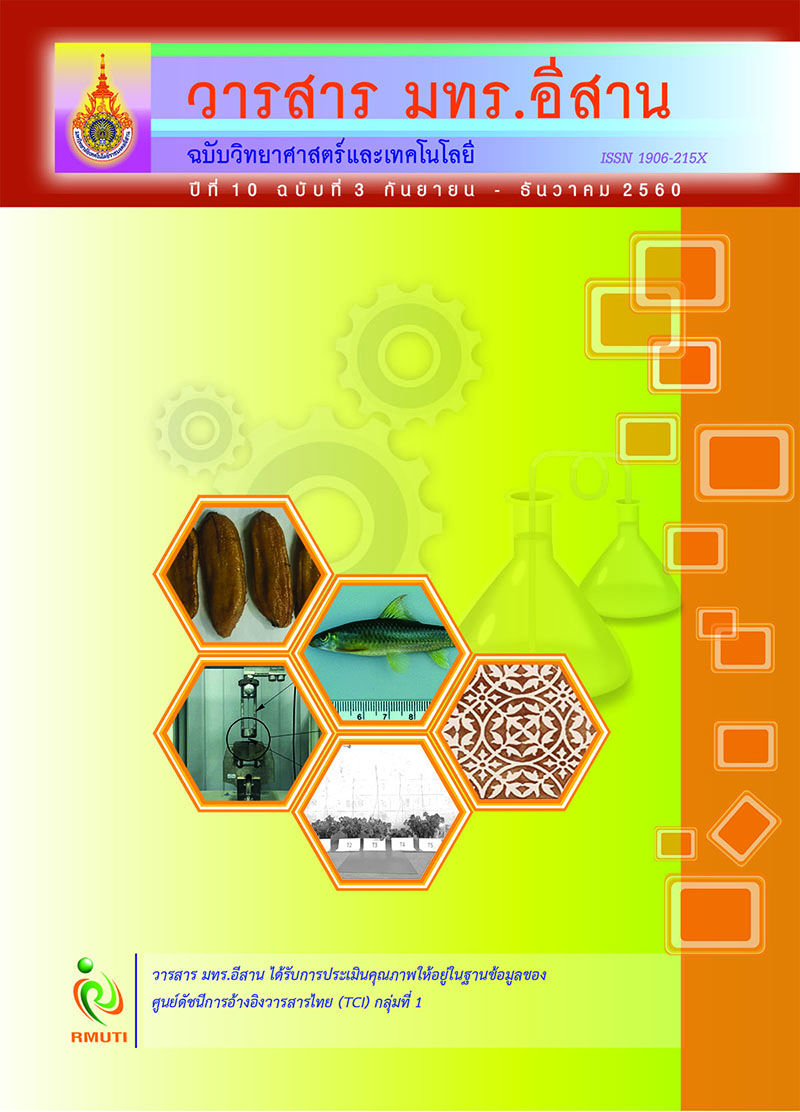Drying Bananas with a Modified Hot Air Dryer Using Waste Heat from a 200 Liter Kiln
Main Article Content
Abstract
The purposes of this research are to modify hot air dryer by using waste heat from a 200 liter kiln for drying bananas and to investigate its drying performance by assessing
its drying rate and specific energy consumption. The main parts of the dryer consist of drying chamber that has dimensions of 0.72 × 1.2 × 0.63 m3, air circulation system and heat exchanger which receives waste heat from the exhaust tube and kiln surface. For the experiment, an initial moisture content of 30 kg bananas was prepared at
239.60±20.30 %dry basis. Drying temperature was set at 60±4oC while drying air velocity was set at 0.6 to 1.8 ms-1. All experiments were carried out in triplicate and the drying period was measured from the initial moisture content less final moisture content, 59.06±6.77 %dry basis. An air velocity of 1.8 ms-1 was the optimal condition in this
experiment. It had the highest drying rate at the lowest specific energy consumption. The results of the average drying rate and the average specific energy consumption
were 0.87±0.004 kgwater h-1 and 51.12±0.70 MJ kgwater -1, respectively.
Article Details
References
[2] Janjai, S., Lamlert, N., Intawee,P., Mahayothee,B., Bala, B.K., Nagle, M. and M ller,J. (2009). Experimental and Simulated Performance of a PV-Ventilated Solar Greenhouse Dryer for Drying of Peeled Longan and Banana. Solar Energy. Vol. 83. Issue 9. pp. 1550-1565
[3] Smitabhindu, R., Janjai,S. and Chankong, V. (2008). Optimization of a Solar-Assisted Drying System for Drying Bananas. Renewable Energy. Vol. 33. No. 7. pp. 1523-1531
[4] Achariyaviriya, S., Achariyaviriya, A. and Chunkaew, P. (2014). Evaluation of Technology Transfer to Rural Communities for Drying Using LPG and Solar Energy Cabinet Dryer. Journal of Agricultural Technology. Vol. 10. No. 5. pp. 1139-1150
[5] Chunkaew, P., Khadwilard, A., and Sheetaval, Ch. (2008). Banana Dryer by Using Hot Air from Electric Heater Combined with Solar Collector. In Proceedings of Maejo University Conference. 4-5 December. Maejo University. Chiang Mai. Thailand. pp. 89-98 (in Thai)
[6] Chunkaew, P. (2009). Design of Two-Cycle Heat Pump Dryer for Banana. In Proceedings of the Ninth Heat and Mass Transfer in Heat Equipment Conference, 11-12 March. Pranburi, Prachuapkhirikhan. Thailand. pp. 11-17 (in Thai)
[7] Khadwilard, A. and Chunkaew, P. (2011). Modified Hot Air Dryer by Leaf Stove for Banana Drying. Energy Procedia. Vol. 9. pp. 344-350. DOI: 10.1016/j.egypro.2011.09.037
[8] Achariyaviriya, S., Moran, J.C. and Chunkaew, P. (2014). Dried Sunflower Seeds Utilizing Technique of Pulsed Fluidized Bed. In Proceedings of ACEAT-145. pp. 661-670
[9] Bala, B.K. (1997). Drying and Storage of Cereal Grains. Science Publisher. Inc. New Hampshire. 12 Drying Bananas with a Modified Hot Air Dryer Using Waste Heat from a 200 Liter Kiln
[10] Achariyaviriya, A. (2001). Simulation and Optimization of the Drying Strategy for Longan Drying. Doctor of Engineering Energy Technology Program School of Energy and Materials. King Mongkut’s University of Technology Thonburi. p. 65 (in Thai)
[11] Chen, Z., Zhu, Q., Wang, X., Xiao, B. and Liu, S. (2015). Pyrolysis Behaviors and Kinetic Studies on Eucalyptus Residues Using Thermogravimetric Analysis. Energy Conversion and Management. Vol. 105. pp. 251-259
[12] Santacatalina, J.V., Soriano, J.R., C rcel, J.A. and Garcia-Perez, J.V. (2016). Influence of Air Velocity and Temperature on Ultrasonically Assisted Low Temperature Drying of Eggplant. Food and Bioproducts Processing. pp. 282-291. DOI:10.1016/j.fbp.2016.07.010


